After the global pandemic forced many offices to shut down, virtual or online workspaces became more popular, as many firms adopted them during the lockdown. The lockdown is behind us, but the remote work model and virtual team workplace are still in vogue. Many firms prefer to hire virtual teams, as employees love remote work positions.
Are you considering setting up a virtual team workplace or transitioning to remote working? These trending virtual team workplace statistics could be all you need to start. This article contains the most valuable stats and insight into the virtual team workplace you need to know in 2025. Let’s dive in!
Key Highlights of Virtual Team Workplace Stats
Why are More Organizations Adopting Virtual Team workspaces?
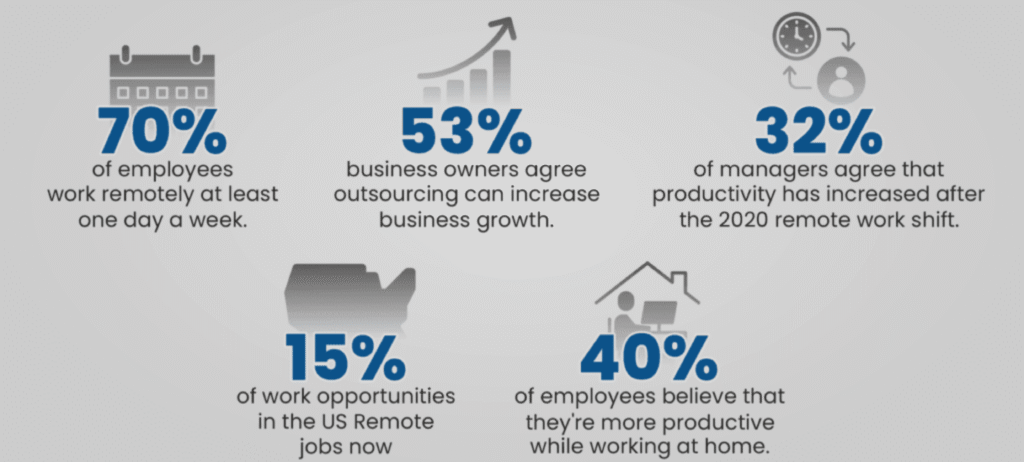
One of the many advantages of remote workplaces that often comes to mind is the flexibility employees get from it. This is particularly true considering that commuting to the office daily can be very stressful, and the virtual workplace eliminates it. There is also the timesaving benefit and assurance of better work-life balance. As a result, employees can take quality time to plan their day to align with their personal needs. The effect of this flexibility goes beyond increased employee morale to higher levels of creativity and productivity.
Besides, companies can depend on virtual workspaces to access a wide range of talents since it’s not limited to a particular geographical location. With this remarkable advantage, it’s easy for businesses to form more substantial and diversified teams, which is one of the primary reasons most companies hire remote staff members. Virtual team workspaces also reduce firms’ operational costs, including managing physical offices. While focusing on the benefits, we must consider some drawbacks of virtual workplaces. A common concern is the loneliness and isolation many remote workers face because of a lack of social interaction.
Notably, having no connection with coworkers could result in employees missing out on physically caring for challenges as a team. Also, there is a lack of support when working side-by-side with teammates. However, many people have acknowledged that the advantages of virtual team workplaces outweigh the limitations. So, regardless of its limitations, the virtual team workplace has been adopted in many organizations and will likely become more mainstream in the coming years. Let’s look at the insights from statistics.
General Statistics on Virtual Team Workplace
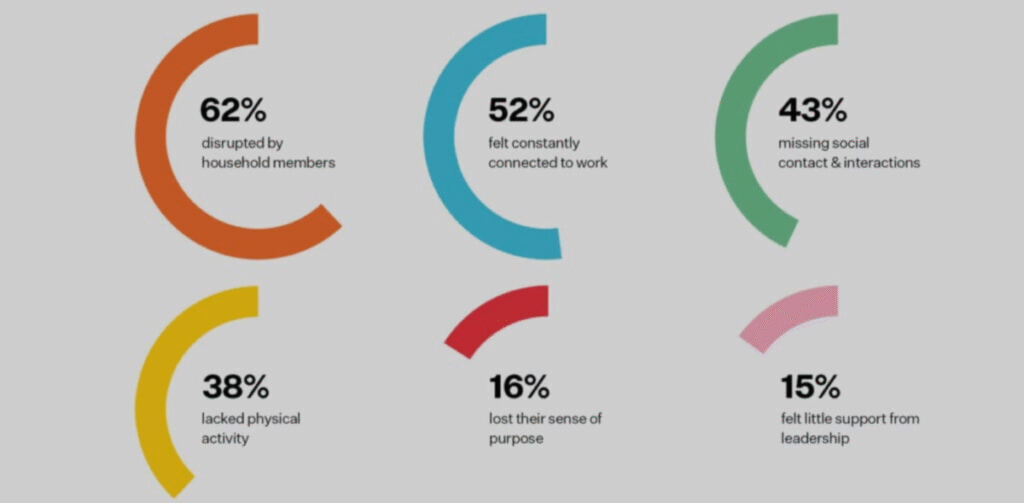
1. Virtual team policies saw a significant uptick in 2020, causing an 80% shift toward remote work.
2. A considerable 62% of the global workforce is open to leaving traditional in-person organizations in favor of those embracing remote work opportunities.
3. Across the globe, a quarter of individuals are part of organizations with a 100% remote work setup, incorporating virtual team practices.
4. The effectiveness of virtual teams sees a boost, with 75% attributing it to enhanced remote collaboration.
5. In 2018, 57% of employers noted that remote work contributed to higher employee morale than in-person arrangements.
6. Virtual teams showcase their productivity prowess, with 42% of employers witnessing a notable increase in work output.
Statistics on Remote Team Workplace Benefits
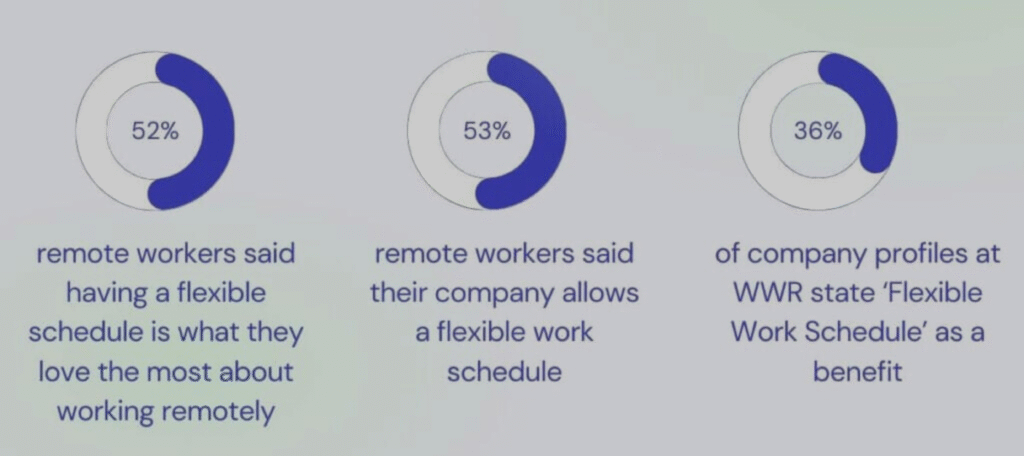
7. Some employers pointed to key benefits of remote work, stating that it boosts employees’ morale by 57%, reduces employee turnover by 52%, and lowers the chances of being absent from work by 50%. They also agreed that this work style saves operational costs by 50% and reduces health insurance by 31%.
8. In 2019, the Society for Human Resource Management identified critical benefits for virtual teams, including exposure to global perspectives (81%), fostering diversity (72%), enhancing creativity (54%), gaining access to talent worldwide (53%), achieving cost-effectiveness (32%), and improving overall productivity (31%).
9. Employees express their satisfaction with remote work through various benefits such as achieving a better work-life balance (75%), experiencing reduced stress (57%), fewer absences (56%), enhanced morale (54%), and a decrease in sick days (50%).
10. Most teams (73%) acknowledge that virtual work’s advantages outweigh potential drawbacks.
11. As of 2018, over half of the global workforce already enjoys the advantages of a flexible workplace, and this trend is likely to persist.
12. A significant 69% of millennials are willing to forget other work benefits in exchange for a more flexible working environment.
13. Remote workers commonly cite the appeal of a “flexible schedule” (32%), the freedom to work from anywhere (26%), and the elimination of commuting (21%).
14. Survey results indicate that employees prioritize healthcare (69%), professional development (63%), and coaching (54%) as the top three desired benefits.
15. A notable 35% of employees agree that the two to five hours spent on weekly meetings yield no tangible benefits.
Employees’ Reaction Toward Remote Work
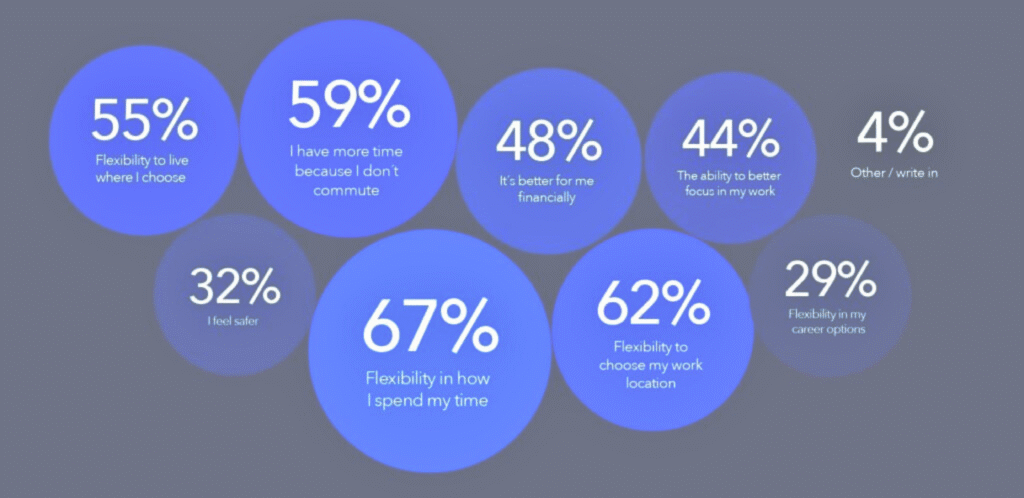
Over the past few years, the opportunity to work remotely has transformed the professional sector for many of us, yielding remarkable results.
16. According to Owl Labs and Global Workplace Analytics research, 74% of workers express increased happiness with remote work. The reasons for this satisfaction range from eliminating commuting hassles to enjoying greater flexibility and spending quality time with family.
17. Notably, the same study reveals that 50% of surveyed employees would willingly accept reduced pay if it meant retaining the remote option. Therefore, if you’re contemplating a return to the office as the pandemic wanes, perhaps it’s worth reconsidering this directive. The Buffer State of Remote Work is valuable for understanding remote work culture. This comprehensive survey delves into the experiences of remote employees, capturing the dynamics of the past two intriguing years.
18. Buffer’s findings suggest that 97% of individuals wholeheartedly recommend remote work to others. Their historical data reveals minimal fluctuations in this endorsement, typically within a percentage point or two.
19. Interestingly, the survey indicates that an identical 97% of remote employees aspire to continue working remotely throughout their entire careers. This shows the need for employers to craft long-term strategies encompassing onboarding, development, and career progression for their remote workforce. While creativeness sufficed during the pandemic, business leaders must anticipate a predominantly remote future.
20. If your initial approach to remote work was a temporary fix, abruptly summoning employees back to the office could lead to an exodus. So, if remote work is no longer an option, plenty of companies are prepared to provide the flexibility many employees seek.
Satisfaction and Trust in Remote Workplaces
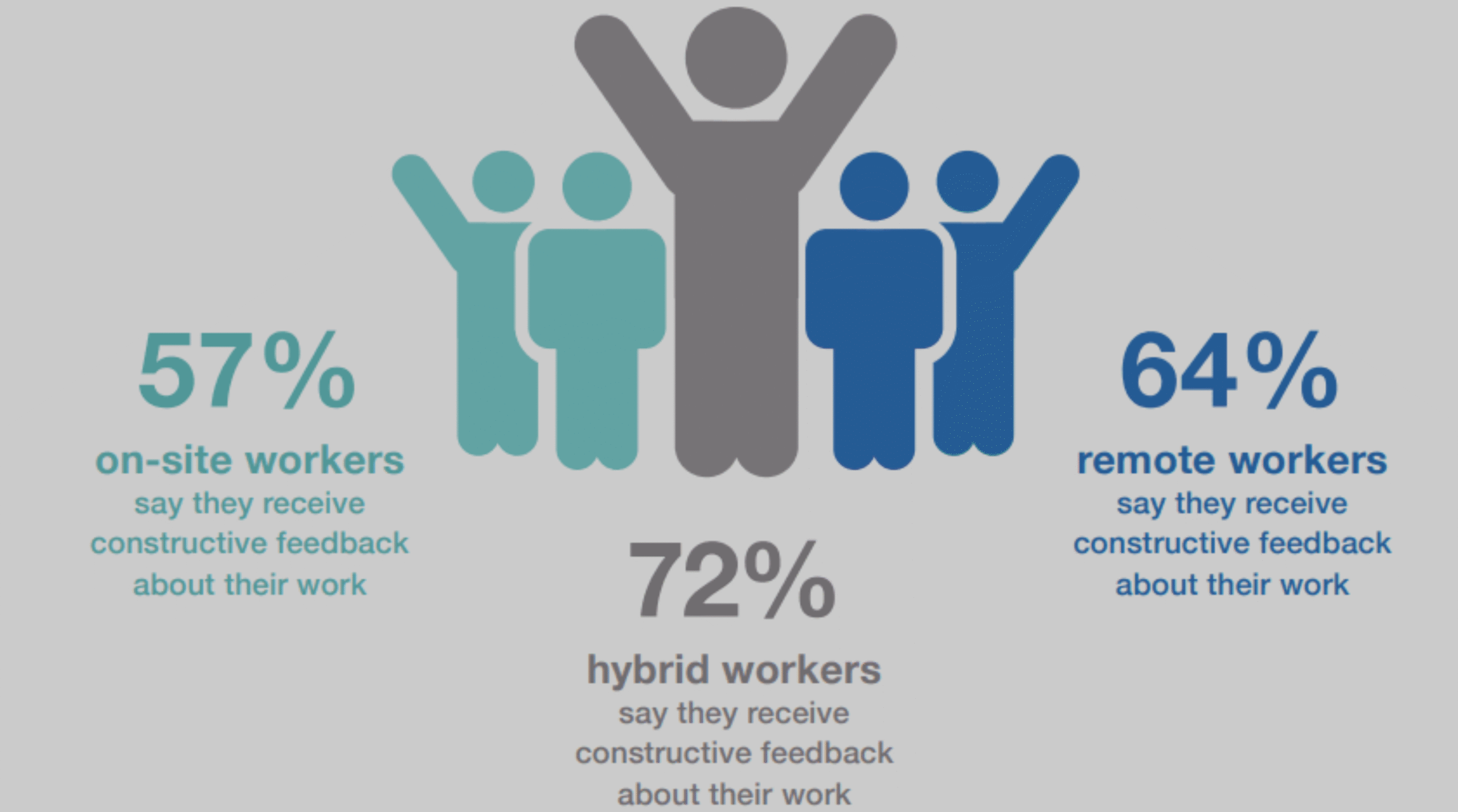
21. The 2023 statistics on remote work revealed high trust among U.S. adults who opt to work remotely. A significant 70% of those working from home, at least part-time, said their managers trust them to complete tasks promptly.
22. Individuals engaged in full-time remote work exhibited the highest sense of trust, with 79% stating that their managers have much confidence in them. This contrasts with the 64% reported by hybrid workers.
23. Hybrid workers, whether in or out of the office, perceive a similar level of trust. When not working remotely, 68% of them believe their managers trust them significantly to accomplish their tasks.
24. Despite the positive outlook in 2023, it’s noteworthy that in 2022, 54% of leaders were concerned about the potential negative impact on productivity due to the shift to remote or hybrid work.
25. The year 2022 presented a challenge for leaders, with 85% facing difficulties in maintaining confidence in employee productivity within a hybrid work environment. Notably, hybrid managers struggled more, with 49% expressing trust issues compared to 36% of in-person managers.
26. Surprisingly, 77% of individuals enjoying the flexibility to choose when and where they work put in more hours in 2022 than they did three years earlier.
27. Despite the more extended workdays, nearly half of these individuals, approximately 46%, reported higher job satisfaction levels.
28. In response to the COVID-19 pandemic, approximately 80% of multinational corporations adjusted their remote work policies, transitioning to virtual or hybrid forms of team collaboration.
29. To facilitate virtual hearings, 91% of courts worldwide employed remote desktop applications as a practical solution.
30. In 2018, Trello reported that 70% of its workforce operated remotely from home or co-working spaces worldwide.
Additional Statistics on Virtual Team Workplace

31. A significant 64% of businesses anticipate adopting virtual team structures, prompted by the pandemic, will become a permanent feature of their operations.
32. During the unprecedented events of 2020, nearly all global courts, 97%, turned to videoconferencing platforms to ensure the continuation of legal proceedings amidst the challenges posed by the pandemic.
33. The effectiveness of virtual teams was acknowledged by 75% of such teams worldwide, attributing their enhanced performance to remote collaboration.
34. A noteworthy 62% of employees worldwide were inclined to consider leaving traditional office setups for opportunities in organizations that offer remote work options.
35. The various departments that could embrace virtual team structures are Human Resources (63% possibility), Sales (62%), Operations (57%), IT (57%), and Finance (56%). As time progresses, finance could be the most likely sector to adopt this collaborative model.
36. A significant shift in team dynamics is observed, as 53% of companies now embrace a more flexible work model than three years ago.
37. On a global scale, 63% of all organizational departments have team members actively engaged in remote work.
38. According to the IWG workplace survey, 62% of businesses worldwide have implemented flexible working policies.
39. Participation in virtual teams experienced a robust 25% growth between 2010 and 2018.
40. Notably, all Buffer employees work within virtual teams spanning 50 cities worldwide, highlighting the prevalence of remote work in the modern professional landscape.
41. By 2016, a quarter of Dell’s workforce had embraced remote work, either partially or full-time.
42. Over 25% of the global workforce is employed in organizations fully committed to remote work, fostering virtual team collaboration across diverse time zones.
43. Approximately 12% of the global workforce operates remotely, adhering to synchronized time zones established by their respective organizations.
Wrapping Up
Remote work has come to stay, considering its influence in today’s professional sector, so virtual team workplaces will likely remain relevant. The continuous positive results virtual teams record yearly show how beneficial it is for employers and employees. Although, for now, it’s impossible to define the long-term impact of remote work on the global work environment, the reports show that now is the right to consider the remote work system. However, these statistics show that the shift in how firms run their operations and the adoption of virtual team workplaces will continue for a long time.
FAQs
As of 2022, 26% of U.S. employees engage in remote work, and 16% of companies operate entirely in a remote setup.
Reports generally suggest that remote workers exhibit higher average productivity. However, there are conflicting viewpoints. Owl Lab’s research emphasizes that productivity hinges on employees’ specific tasks, offering a more nuanced perspective.
Industries such as information technology, management, and consulting boast the highest level of remote workers. Nonetheless, more individuals in the financial sector will likely embrace the remote system.
Remote work has been proven to elevate employee happiness by 20%. More generally, there are happier remote employees than those who work on-site.
Although remote work has experienced a significant decline since its peak in 2020, the current adoption rate remains five times higher than 2019. This suggests a continued preference for remote work among many organizations. The evolving trend indicates that the future of work is likely to be a hybrid model, blending both remote and on-site work experiences.
